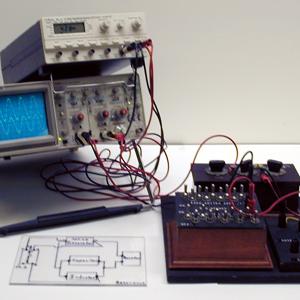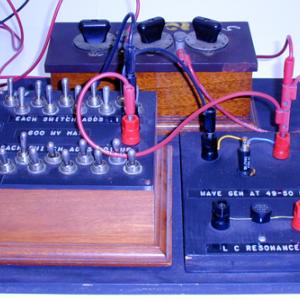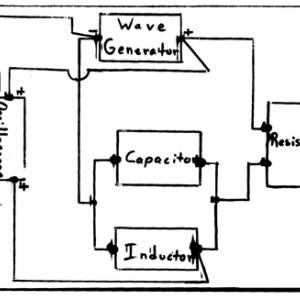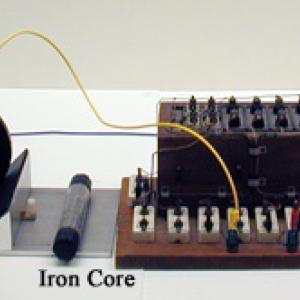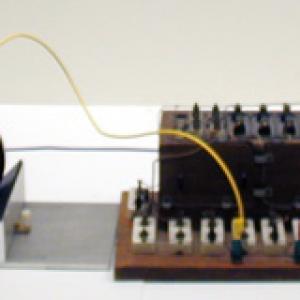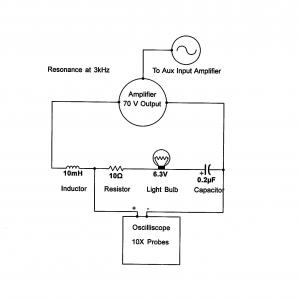College of Liberal Arts & Sciences
5L20.21 - Resonance Circuits
Connect the labeled leads to the proper inputs of the oscilloscope and the wave generator. Attach the proper capacitance box if not already in place (These are just stuck on with Velcro). Set the wave generator to the 1 to 100 KHz range. As you sweep the generator through the range you will see a point of maximum resonance on the oscilloscope. The reference trace on the scope is the direct generator input.
Assemble the circuit with the Variac, capacitor, inductor, and light all in series. With the proper capacitance value the circuit will go in and out of resonance as you insert and remove the iron core in the inductor coil. The light bulb is used as a visual indicator of this phenomenon. Usually for this demo the capacitor is set for 24 mfd which will mean that the light will come on when you turn the Variac up and will go out when you insert the core. However, you can also set the capacitor at 6 mfd, and when you turn the Variac up the light bulb will glow dimly. As you insert the iron core the light gets brighter, and as you continue to insert the core you go past resonance and the light once again becomes dim.
You may use a 6 volt light bulb as an indicator of circuit resonance if desired. Put the wave generator, capacitor, inductor, and amplifier all in series. The speaker output of the amplifier is connected to the 6 volt bulb. Sweep the frequency between 0 and 10 kHz. and observe the resonance.
- Fabiana Botelho Kneubil, "Driven Series RLC Circuit and Resonance: A Graphic Approach to Energy", TPT, Vol. 58, #4, April 2020, p. 256.
- Yaakov Kraftmakher, "Two Demonstrations with a New Data-Acquisition System", TPT, Vol. 52, #3, Mar. 2014, p. 164.
- Philip Backman, Chester Murley, and P. J. Williams, "The Driven RLC Circuit Experiment", TPT, Vol. 37, # 7, p. 424, Oct. 1999.
- Se-yuen Mak, "Qualitative Demonstrations of Parallel/Series Resonance", TPT, Vol. 37, #3, Mar 1999, p. 179.
- S. Y. Mak and P. K. Tao, "Measurement of Self-Inductance", TPT, Vol. 26, #6, Sept. 1988, p. 378.
- Jim Oliver, "Observing Voltage Phases in RC, RL, and RLC Circuits", TPT, Vol. 35, #1, Jan. 1997, p. 30.
- Russell Akridge, "AC Reactance Without Calculus", TPT, , Vol. 35, #1, Jan. 1997, p. 20.
- Zenon Gubanski, "Damped Oscillations", TPT, Vol. 7, #1, Jan. 1969, p. 59.
- David D. Lockhart, "Effect of Variable Frequencies on Reactive Circuits", TPT, Vol. 7, #1, Jan. 1969, p. 59.
- Pierre Cafarelli et al, "The RLC System: An Invaluable Test Bench for Students", AJP, Vol. 80, #9, Sep. 2012, p. 789.
- Michael C. Faleski, "Transient Behavior of the Driven RLC Circuit", AJP, Vol. 74, #5, May 2006, p. 429.
- Zdenek Hurych, "Study of the Phase Relationships in Resonant RCL Circuits Using A Dual-Trace Oscilloscope", AJP, Vol. 43, #11, Nov. 1975, p. 1011.
- Keung L. Luke, "Laboartory Investigation of Free and Driven Oscillations Using A RLC Circuit", AJP, Vol. 43, #7, July 1975, p. 610.
- W. A. Hilton, "Resonance Experiment", Apparatus Notes, July 1965-December 1972, p. 56.
- Freier and Anderson, "En-1, Eo-15", A Demonstration Handbook for Physics.
- Richard Manliffe Sutton, "A-26", Demonstration Experiments in Physics.
- Richard Berg, Rich Baum, K7-27 - RLC Circuit Demonstration, June 1999, plus included circuit diagram.
- "Basic Direct Current Measurements", Lab Experiment, Johns Hopkins University, 2005.
- Yaakov Kraftmakher, "3.2. LCR Circuit", Experiments and Demonstrations in Physics, ISBN 981-256-602-3, p. 149.
- Robert L. Wild, "LRC Circuit", Low-Cost Physics Demonstrations, # 148, p. 87.
- "Simple Alternating-Current Series Circuit", Selective Experiments in Physics, CENCO, 1962.
- "Alternating-Current Series Circuit", Selective Experiments in Physics, CENCO, 1962.
- "Kirchhoff's Laws", Selective Experiments in Physics, CENCO, 1962.
- W. Bolton, "36. Voltage Magnification With A Resonant Circuit", Book 4 - Electricity, Physics Experiments and Projects, 1968, p. 69 - 70.
- W. Bolton, "33. Electrical Resonance", Book 4 - Electricity, Physics Experiments and Projects, 1968, p. 64.
- W. Bolton, "30. Alternating Current Applied to a Resistor, A Capacitor and an Inductor", Book 4 - Electricity, Physics Experiments and Projects, 1968, p. 57 - 58.
- W. Bolton, "6. Electrical Circuit Energy Level", Book 3 - Atomic Physics, Physics Experiments and Projects, 1968, p. 20 - 21.
Disclaimer: These demonstrations are provided only for illustrative use by persons affiliated with The University of Iowa and only under the direction of a trained instructor or physicist. The University of Iowa is not responsible for demonstrations performed by those using their own equipment or who choose to use this reference material for their own purpose. The demonstrations included here are within the public domain and can be found in materials contained in libraries, bookstores, and through electronic sources. Performing all or any portion of any of these demonstrations, with or without revisions not depicted here entails inherent risks. These risks include, without limitation, bodily injury (and possibly death), including risks to health that may be temporary or permanent and that may exacerbate a pre-existing medical condition; and property loss or damage. Anyone performing any part of these demonstrations, even with revisions, knowingly and voluntarily assumes all risks associated with them.
